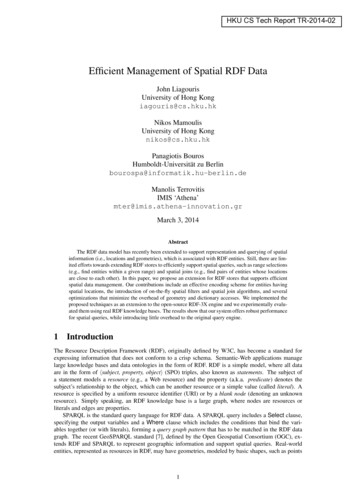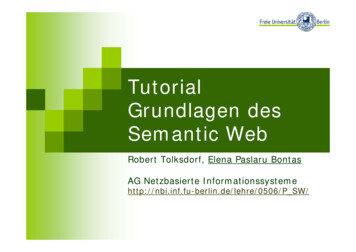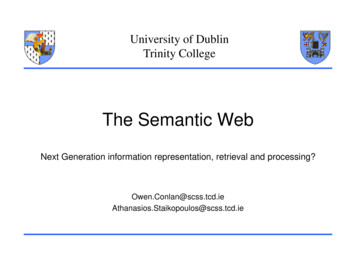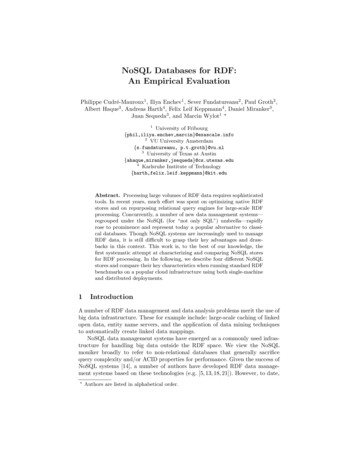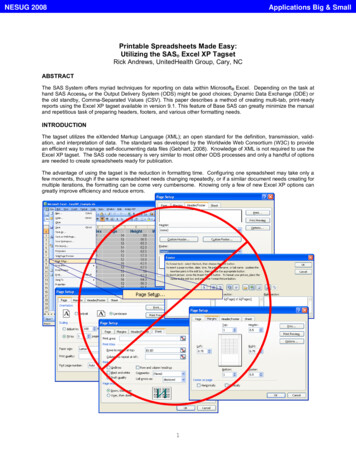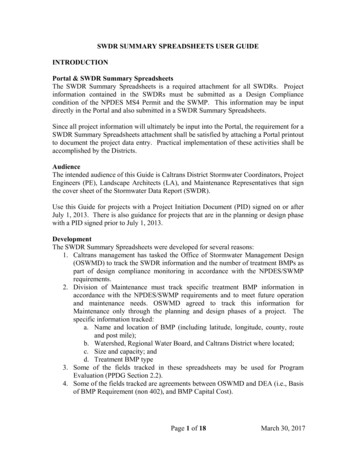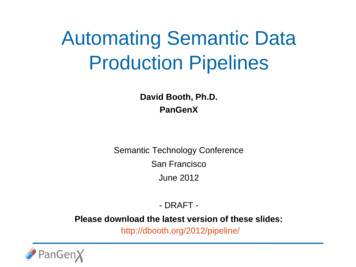
Transcription
Mapping Spreadsheets to RDF:Supporting Excel in RMLMarkus Schröder, Christian Jilek, and Andreas Dengel1Smart Data & Knowledge Services Dept., DFKI GmbH, Kaiserslautern, Germany2Computer Science Dept., TU Kaiserslautern, Germany{markus.schroeder, christian.jilek, andreas.dengel}@dfki.deAbstract. The RDF Mapping Language (RML) enables, among otherformats, the mapping of tabular data as Comma-Separated Values (CSV)files to RDF graphs. Unfortunately, the widely used spreadsheet formatis currently neglected by its specification and well-known implementations. Therefore, we extended RML Mapper to support Microsoft Excelspreadsheet files and demonstrate its capabilities in an interactive onlinedemo. Our approach allows to access various meta data of spreadsheetcells in typical RML maps. Some experimental features for more specificuse cases are also provided. The implementation code is publicly availablein a GitHub fork.Keywords: Spreadsheet · Excel · RML · RDF · Knowledge Graph1IntroductionAs soon as knowledge graphs have to be constructed from given data, theuse of mapping languages is a common practice. Such languages let users definedeclarative rules to map various input data formats to a complex interconnectedgraph. In the Semantic Web community such graphs are usually modeled withthe Resource Description Framework (RDF) [10] and (semi-)structured datais mapped with the RDF Mapping Language (RML) [2] – a superset of theW3C-recommended mapping language R2RML [9]. The specification of RML[1] describes how semi-structured data, like XML or JSON, and tables in formof Comma-Separated Values (CSV) can be mapped properly. However, tabulardata can also be found in other file types, prominently in spreadsheets.Since the spreadsheet methodology enables a well understood, easy and fastpossibility to enter data, they are widely used by knowledge workers, especially inthe industrial sector. In contrast to simply structured CSV files, spreadsheets canmodel complex workbooks containing multiple sheets with cells having rich metadata. Besides its content, a single cell may store additional information such as itsappearance (colors, styles and borders) or cell comments. How these cells shouldCopyright 2021 for this paper by its authors. Use permitted under CreativeCommons License Attribution 4.0 International (CC BY 4.0).
Markus Schröder, Christian Jilek, and Andreas Dengelbe filled or styled by users is not predetermined by spreadsheet applicationsin general. As a consequence, in practice, cells can contain inconsistent andunstructured content which can be arbitrarily arranged in a sheet. That is why amapping of such data to RDF can become a challenging task.Although spreadsheets are frequently used in industry, well-known RML-basedmappers such as RML Mapper3 , CARML4 , RocketRML [8] or SDM-RDFizer [4]currently do not support them natively. To fix this issue, in this demo paper weextended RML Mapper to support Microsoft Excel spreadsheet files. We havechosen RML Mapper because its code structure lets us easily integrate our newcode. Natively supporting spreadsheets in RML has several advantages. There isno need anymore to preprocess and transform spreadsheets in a format that canbe handled by a mapping tool (e.g. CSV). Compared to CSV-based processingtools (like csvtk5 ), we are able to exploit all aspects of spreadsheets in a mapping.This also eliminates extraneous conversion efforts for mapping experts and letthem focus on defining proper rules. Having RML rules that directly refer tospreadsheet data eases the communication with data providers about how theirspreadsheets will be mapped to a knowledge graph. Additionally, practitioners ofRML who already learned the language become able to map spreadsheets withalmost no extra effort.In summary, this demo paper presents the following contributions to RML:– an implementation to access Excel spreadsheets via an RML logical sourcein order to iterate (and also filter) cells in sheets– a mechanism to retrieve cell meta data by relative and absolute distances inan RML reference formulation– two experimental features to map from one cell (a) information of differentproperties and (b) multiple complex entities– a prototypical implementation of the features in RML MapperIn the next section, we describe in detail how we realized the Excel support inRML.2Supporting Excel in RMLOur approach is implemented as an extension to the RML Mapper tool in aseparate GitHub fork6 . For demonstration purpose, we additionally provide aninteractive demo page7 where visitors can try various mapping examples.At its core, our component utilizes the Apache POI8 library to read MicrosoftExcel spreadsheets as a first step, but it is conceivable in future to support dfki.uni-kl.de/ mschroeder/demo/excel-rmlhttps://poi.apache.org
Mapping Spreadsheets to RDF: Supporting Excel in RMLother spreadsheets such as LibreOffice or Google Spreadsheets by using appropriate APIs. In order to refer to spreadsheet contents as a logical source, a smallspreadsheet ontology9 (usually prefixed with ss) was designed. As demonstratedin Listing 1.1, using a spreadsheet reference formulation (Line 2), a workbooksource should name a spreadsheet file (Line 5), a referring sheet by name (Line6) and a range of cells in the sheet (Line 7). A triples map that uses this logicalsource will iterate over single cells in the given range.Listing 1.1: Exemplary RML definition of a spreadsheet file as a logical source.12345678910[ a rml : L o g i c a l S o u r c e ;rml : r e f e r e n c e F o r m u l a t i o n q l : S p r e a d s h e e t ;rml : s o u r c e [a s s : Workbook ;s s : u r l ” workbook . x l s x ” ;s s : sheetName ” P a p e r s ” ;s s : r a n g e ”A2 : A5” ;s s : j a v a S c r i p t F i l t e r ”/Know\\w / . t e s t ( v a l u e S t r i n g ) ” # o p t i o n a l]]Optionally, a filter can be added that picks certain cells based on a JavaScriptprogram (Line 8). Regarding our example, a regular expression is used to iterateover only those cells which contain the phrase “Know”. Using the expressivescript language and variables that represent cell meta data, appropriate filterprocedures can be realized. However, it is also conceivable to implement it as anFn O function instead, which receives cell meta data and returns a boolean value.Listing 1.2: Demonstration of how cell meta data can be accessed in RML maps.1234567891011r r : subjectMap [r r : t e m p l a t e ” h t t p : / / example . o r g /{ a d d r e s s }”] ;r r : predicateObjectMap [r r : predicateMap[r r : t e m p l a t e ” h t t p : / / example . o r g / { [ 2 , 0 ] . v a l u e S t r i n g }”] ;r r : objectMap [rml : r e f e r e n c e ” ( 2 , 0 ) . v a l u e N u m e r i c ”]]In various RML maps, meta data of the currently iterated cell can be retrieved, asdemonstrated in Listing 1.2. For example in Line 2, a template expression insertsthe cell’s address (like “A2”) to form a unique URI for a subject resource. However,often it is required to refer to nearby cells in order to construct appropriatestatements. To refer to other cells relatively from the current cell, we introducea parenthesis notation, like (column,row). A column shift (x-axis of the sheet)and a row shift (y-axis of the sheet) allows to reach any cell relative to the cellrepresenting the subject resource. Regarding Line 9 of our example, numericvalues which are located two columns away on the right are used as objects inthe mapped statements. In a similar way, cells can be referenced absolutely byusing square brackets (Line 6). We use relative and absolute distances, because9http://www.dfki.uni-kl.de/ mschroeder/ld/ss
Markus Schröder, Christian Jilek, and Andreas Dengelspreadsheets in general can contain arbitrarily structured tables without anyanchor points like column names (in contrast to CSVs).As already mentioned, spreadsheet cells have several meta data values thatneed to be retrievable in a mapping through variables (written in the followingwith monospaced font). A cell’s location in a sheet can be accessed either as a usualspreadsheet address or as column and row indices. Since a cell (if not empty)stores either a string value or a numeric value, various possibilities are given toaccess its content: valueNumeric retrieves a floating point value (valueInt aninteger value), valueBoolean a boolean value, valueFormula if a cell contains aformula (valueError to get its possible error code) and valueString retrievesits text content. Besides content, one could also be interested in the appearance ofa cell in a sheet: since it can be colored, backgroundColor and foregroundColorcan be queried as a hexadecimal RGB value. Regarding the used font, fontColor,fontName and fontSize are available. On a more fine-grained level, cells canalso store formatted text which is returned by valueRichText. The formattedtext is represented in an HTML syntax to enable usual XML-parsers to accesstags and attributes, for example,“ăbąăiąăfont face ’Arial’ color ’#ff0000’ąred, italic and boldă/fontąă/iąă/bą”.If spreadsheets were completed in an inconsistent manner, it happens thatcells were unintentionally filled with different data types. For such cases, one canuse the value variable to always obtain a string representation of a cell’s contentregardless of its cell type. However, if this is not sufficient because more detailsare needed, the json variable could be used to retrieve a JavaScript ObjectNotation (JSON) representation of a cell. The JSON object contains, besides thecell type, various data types mentioned above.In our demo implementation, we do not retrieve all aspects of a spreadsheet(e.g. border thickness), yet they could easily be added to our code if desired.2.1Experimental FeaturesWe also would like to propose some experimental features that we found useful inour use cases. However, the official introduction of these extensions would requireto change the RML specification on some points.Multiple Different Properties in a Cell. In our use cases, we frequentlyexperienced that users record multiple information in one cell. Each piece ofinformation ij P I then corresponded to a different property pj P P . Following thecurrent RML specification, one has to define for each pj P P a separate predicateobject map. Instead, we propose a shortcut such that only one predicate-objectmap is needed. This is done by allowing that an RDF list of properties pj P Pcan be passed in a predicate map. By implementing a suitable Function Ontology(Fn O) [6] procedure, we extract information pieces ij P I from a cell’s contentand return them as an object list oj P O. Usually, RML provides that a Cartesianproduct is formed between predicates and objects which is P ˆ O. However,in our case we need to zip predicate and object lists such that the followingset is made: tppj , oj qu. Thus, instead of all possible pairs of the P ˆ O matrix,
Mapping Spreadsheets to RDF: Supporting Excel in RMLonly the diagonal ones are selected. This new behavior is activated by adding ass:zip true statement to a predicate-object map.Multiple Complex Entities in a Cell. Similarly to the previous observation,we often discovered that users mention several entities in a single cell. A prominentexample is a list of persons having first and last names, for instance book authors.Represented as an RDF graph, such complex entities potentially require severalstatements to be fully expressed. An Fn O function that is able to perform entityextraction would need to return an arbitrary large RDF graph in a certainserialization format (e.g. Turtle) instead of a single value. In order to integratesuch a return value in an object map, we define a new term type ss:Graph.Once this term type is chosen, the returning RDF graph is parsed and addedto the emerging knowledge graph. To prevent that all returning resources aremapped in the object map, a special ss:SelectedObjects resource togetherwith rr:object statements should be returned by the function, too. This way, allresources are added to the knowledge graph, yet only selected ones are mapped.3Related WorkIn the past, several similar approaches were implemented that map spreadsheetsto RDF using a language. Domain specific languages (DSL) other than RML areprovided to let knowledge engineers express how input data shall be mapped toa graph structure.Spread2RDF10 uses a Ruby-internal language while M 2 (Mapping Master)[7] builds upon a compact syntax for OWL ontologies (Manchester syntax).Sheet2RDF [3] uses a special ProjEction of Annotations Rule Language (PEARL),whereas XLWrap [5] utilizes template graphs together with a special expressionlanguage to refer to contents of sheets. A different approach is followed byTabLinker11 which requires that input spreadsheets are annotated in advancewith certain styles.With our implementation, we combine the feature of mapping spreadsheetswith the advantages of the well specified RML approach. Those who alreadyused the language and need to process spreadsheets do not have to look for analternative anymore.4Conclusion and OutlookIn this paper we discussed that spreadsheets, despite being widely used, are stillnot supported by the RDF Mapping Language (RML). We therefore proposed afirst solution which extends the already existing RML Mapper tool with necessarycomponents. Additionally, experimental features were introduced too. A publiclyavailable web page12 demonstrates the new erhttp://www.dfki.uni-kl.de/ mschroeder/demo/excel-rml
Markus Schröder, Christian Jilek, and Andreas DengelIn the future, we plan to integrate our proposed solution in the RML specification [1] so that other RML tools may support spreadsheets too. Further, we intendto run several performance tests (e.g. memory consumption) and compliancetests with our current reference implementation. This could be included in theR2RML implementation report13 .Acknowledgements This work was funded by the BMBF project SensAI (grantno. 01IW20007).References1. Dimou, A., Sande, M.V.: RDF Mapping Language (RML). https://rml.io/specs/rml/ (2020), accessed: 2021-02-012. Dimou, A., Vander Sande, M., Colpaert, P., Verborgh, R., Mannens, E., Van deWalle, R.: RML: a generic language for integrated RDF mappings of heterogeneousdata. In: Proceedings of the 7th Workshop on Linked Data on the Web. CEURWorkshop Proceedings, vol. 1184 (Apr 2014)3. Fiorelli, M., Lorenzetti, T., Pazienza, M.T., Stellato, A., Turbati, A.: Sheet2rdf: aflexible and dynamic spreadsheet import&lifting framework for RDF. In: CurrentApproaches in Applied Artificial Intelligence - 28th International Conference onIndustrial, Engineering and Other Applications of Applied Intelligent Systems,IEA/AIE 2015, Seoul, South Korea, June 10-12, 2015, Proceedings. Lecture Notesin Computer Science, vol. 9101, pp. 131–140. Springer (2015)4. Iglesias, E., Jozashoori, S., Chaves-Fraga, D., Collarana, D., Vidal, M.: Sdmrdfizer: An RML interpreter for the efficient creation of RDF knowledge graphs. In:CIKM ’20: The 29th ACM International Conference on Information and KnowledgeManagement, Ireland, October 19-23, 2020. pp. 3039–3046. ACM (2020)5. Langegger, A., Wöß, W.: Xlwrap - querying and integrating arbitrary spreadsheetswith SPARQL. In: The Semantic Web - ISWC 2009, 8th International Semantic WebConference, ISWC 2009, Chantilly, VA, USA, October 25-29, 2009. Proceedings.Lecture Notes in Computer Science, vol. 5823, pp. 359–374. Springer (2009)6. Meester, B.D., Dimou, A., Verborgh, R., Mannens, E.: An ontology to semanticallydeclare and describe functions. In: The Semantic Web - ESWC 2016 Satellite Events,Heraklion, Crete, Greece, May 29 - June 2, 2016, Revised Selected Papers. LectureNotes in Computer Science, vol. 9989, pp. 46–49 (2016)7. O’Connor, M.J., Halaschek-Wiener, C., Musen, M.A.: M2: A language for mapping spreadsheets to OWL. OWL: Experiences and Directions (OWLED), SixthInternational Workshop (2010)8. Simsek, U., Kärle, E., Fensel, D.: Rocketrml - A nodejs implementation of a usecase specific RML mapper. In: Joint Proceedings of the 1st International Workshopon Knowledge Graph Building and 1st International Workshop on Large ScaleRDF Analytics (ESWC 2019), Portorož, Slovenia, June 3, 2019. CEUR WorkshopProceedings, vol. 2489, pp. 46–53. CEUR-WS.org (2019)9. World Wide Web Consortium: R2RML: RDB to RDF mapping language. https://www.w3.org/TR/r2rml/ (2012), accessed: 2021-02-0110. World Wide Web Consortium: RDF 1.1 Primer. https://www.w3.org/TR/rdf11primer/ (2014), accessed: implementation-report
mapping of such data to RDF can become a challenging task. . 6 rr : template "http :// example . org /f[2 ,0]. valueString g" 7 ] ; . Mapping Spreadsheets to RDF: Supporting Excel in RML only the diagonal ones are selected. This new behavior is activated by adding a ss:zip true statement to a predicate-object map. .
